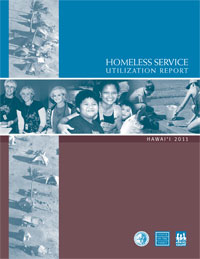
University of Hawaiʻi at Mānoa’s Center on the Family and the Homeless Programs Office of the Hawaiʻi State Department of Human Services released the Homeless Service Utilization Report: Hawaiʻi 2011.
Authored by College of Tropical Agriculture and Human Resources Assistant Specialist Sarah Yuan and Junior Specialist Ivette Rodriguez Stern, the report provides state- and county-level data about the individuals and households who accessed homeless support services during the 2011 fiscal year.
The report includes information for both the Shelter Stipend Program (i.e., emergency and transitional shelter services) and Outreach Program (i.e., services to those living in a car or park or on a beach).
Report highlights
- From July 1, 2010, to June 30, 2011, the Shelter and Outreach Programs served a total of 14,200 individuals statewide, a slight decrease of 3 percent from a year ago.
- About a quarter (23 percent) of the homeless service users were children under the age of 18.
- Among the 10,940 adult clients, 20 percent reported having a disabling condition; 12 percent were considered long-term homeless and 9 percent considered chronically homeless.
- The Shelter Program served 8,299 homeless individuals and the Outreach Program served 8,266 homeless individuals in fiscal year 2011. About 17 percent of the clients received services from both programs.
- During the 2011 fiscal year, 5,831 individuals who received homeless services exited from the service program, representing 41 percent of the total number (14,200) of clients served statewide.
“We developed the report to provide easy access to important statistics on the homeless, especially for those who need the data to improve policies, programs and services for the homeless,” says Yuan, lead author of the 2011 report.
“The use of the Homeless Management and Information System data will help us to make better decisions and take appropriate actions to reduce homelessness in Hawaiʻi” adds Sandra Miyoshi of the Department of Human Services. “Despite the gains we’ve made in the past few years, there is a continuing need to move homeless people into permanent housing.”

